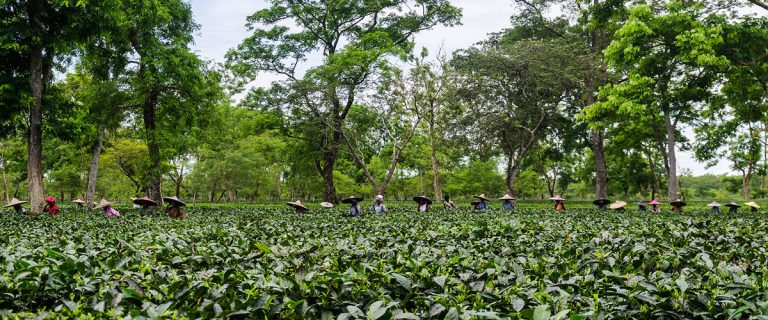The story of Assam tea is about being discovered by a Scottish adventurer, Robert Bruce, who noticed tea-like plants growing wild near Rangpur. This was in 1823 and Bruce was on a trading mission. Bruce was reportedly directed by Maniram Dewan to Bessa Gam who was the local Singpho chief. Bessa Gam showed Bruce how local tribesmen (known as the Singhpos) brewed tea from leaves of this bush. Bruce made an arrangement with the tribal chief to give him samples of these tea leaves with seeds, as he planned on having them scientifically examined. Robert Bruce passed away a few years later, never having seen this plant being properly classified.
In early 1830, Robert Bruce’s brother, Charles, sent a few of these leaves to a botanical garden in Calcutta to be properly examination and it was then that this plant was officially classified as a tea variety and named Camellia sinensis var. Assamica.
The first company that was set up for growing and making this tea was the Assam Tea Company, started in the year 1839. It expanded steadily and by 1862, the business comprised over 160 gardens, all owned by 5 public companies along with 57 private players.
The British East India Company’s intervention was recognised through ‘experts’ who constituted the 1834 Tea Committee and they assessed the commercial potential and scientific nature of the Assam tea. By late 1830s, a market for the Assam Tea began to be evaluated in London and the East India Company’s positive feedback led to the inauguration of a lengthy process of withdrawal of agricultural lands and forests to allow significant shares of this province to be converted to tea plantations by the private capital.
The environment for tea
Assam is located in north-east India. It surrounds the northern Himalayas, the Brahmaputra plains, and the Deccan plateau, making it one of the richest biodiversity zones in the world. Assam experiences heavy rainfall and humid atmospheric conditions throughout the year. This topography forms one of the richest biodiversity zones in the world and is home to some of the endangered species of flora and fauna, including the one-horned Indian Rhinoceros. The valley is fertile and offers rich loamy soil to the region, creating the perfect natural setting for the production of tea.

Tea production in Assam
Between 1840 to 1860, the production and cultivation of Assam tea was dominated by the Assam Company, operating from districts in Upper Assam. The workforce was made up of the local Kacharis. The success of the Company shifted with changes in colonial policies, offering plots to tea planters. It led to the boom and expansion of Assam’s tea industry during the early 1860s.
The Assam tea industry is one of the most enterprising tea-producing regions in the world. Tea estates in Assam collectively produce close to 507 million kg of tea every year, making the state of Assam the world’s largest tea-growing region. The terroir of Assam is characterized as having low altitude, rich loamy soil, ample rainfall, and a tropical climate which allows the region to produce some of the best loose-leaf orthodox teas. Only those teas grown and manufactured in tea estates located in the Brahmaputra Valley in the northeast India qualify to be called as Assam teas.
The harvesting of Assam tea is generally done twice each year – the first flush which begins late March and goes on until late May; and the second flush which is usually in June and makes the famous “tippy” tea. The tippy tea from the second flush has a fuller body and is sweeter, therefore considered as superior to the first flush. You can buy authentic high quality Assam tea right here.
Tea grades produced in Assam
Assam tea region is known for producing both Orthodox as well as CTC (Crush, Tear, Curl) variety of teas. Popular grades produced in Assam include the whole leaf, broken leaf, fannings, and dust. Of these, only the latter three can be produced via CTC method and leg cut manufacturing process.
What to expect of Assam tea
The black teas produced in this region are renowned world over for their strong, bold, brisk, malty flavors and dark liquor making it an ideal pick for a breakfast tea world over. The ever-popular English Breakfast and Irish Breakfast tea blends are made using Assam black tea.
Here’s a list of stories from Assam, its tea gardens and history:
The Teabox team in Assam
The Singphos of Assam: The first Indians to find and drink tea
A visit to the Halmari tea estate
A history lesson at Koilamari estate
Majulighur and Gingia estates in Assam


Comments are closed.